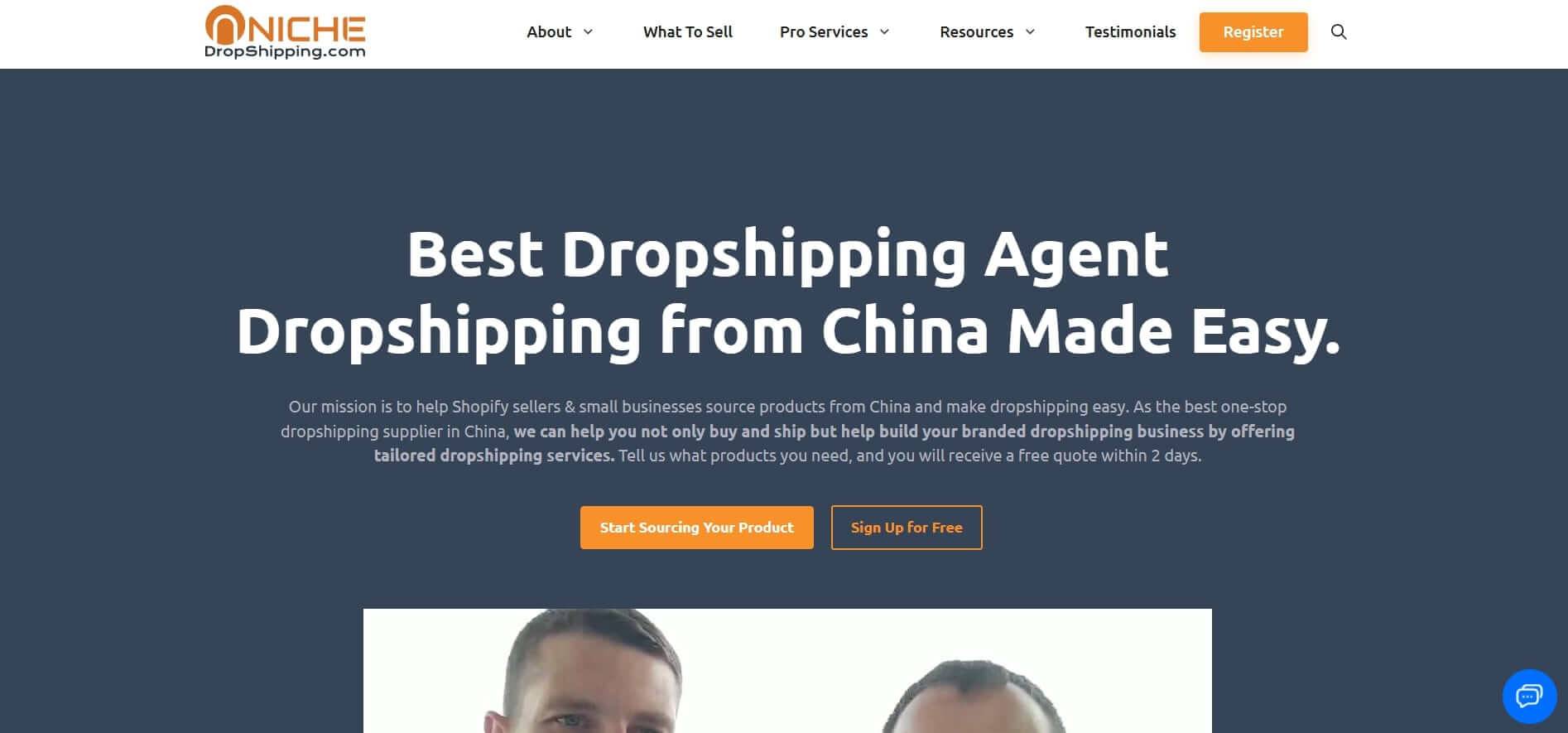Dropshipping has become a popular buzzword online, with countless videos and articles promising big profits.
But here’s the truth: knowing what dropshipping is isn’t the same as understanding how it works.
Many people jump into dropshipping without the right research, and as a result, they fail to make it profitable.
In this Dropshipping for Dummies guide, we’re doing things differently. We’re not here to hype you up with flashy promises.
Instead, we’re breaking it down, step by step, to show you how dropshipping really works.
This guide will answer all the key questions you need to know to set up and run a successful dropshipping business.
Let’s jump straight into it!
What Is Dropshipping?

Before you can succeed in dropshipping, it’s important to understand how the business model works.
At its core, dropshipping is a retail fulfillment method where you don’t handle the products yourself.
In simple terms, dropshipping allows you to sell products from suppliers without managing inventory or handling shipping.
Instead, when a customer buys a product from your online store, the order goes directly to the supplier, who then fulfills and ships it to the customer.
With dropshipping, your job is to market and sell the products, while the supplier handles the inventory and fulfillment process.
It’s a model that’s low on risk and high on potential, making it a great option for beginners.
How to Start Dropshipping? (Step-by-Step Process)
So far we have covered the ups, the downs, and the fundamental basics of dropshipping. The next natural step would be to discuss how you can go about setting up your dropshipping store.
As promised, we will not be glossing over any of the details. Here is a detailed and orderly guide on how to begin dropshipping.
Step 1: Find a Profitable Niche

Finding a profitable niche involves choosing which products to sell. For a market niche to be profitable, it would ideally:
- Not be saturated by other dropshippers selling the same items
- Include products that are in high demand among customers
- Include products that can be sold at a reasonable profit margin
- Include products that are legal and that you can find dropshipping suppliers for
It is equally important to mention that a niche can comprise a wide variety of products. Beauty products, for example, are a niche of their own.
You need to be more specific with your target market.
What we mean by that is, the key to a profitable niche is being specific. Let’s say you choose the beauty industry—don’t just sell generic beauty products.
You could opt for a sub-niche like “natural skincare for sensitive skin” or “cruelty-free makeup for dark skin tones.”
By honing in on a smaller segment, you reduce competition and increase your chances of appealing to a dedicated customer base.
Step 2: Find Dropshipping Suppliers

Once you have a definitive list of the products you would like to sell, you can begin looking for dropshipping suppliers. Let’s evaluate some avenues you could use to find dropshipping suppliers.
- An internet search – This is an easily accessible method and could come in handy if you are on a tight budget. Still, it is time-consuming as you have to visit supplier websites individually and make inquiries.
- A dropshipping platform – Platforms such as SaleHoo and Spocket offer curated lists of suppliers of different products. You may, however, need to pay a subscription fee to access them.
- An online marketplace – Online marketplaces such as AliExpress are a hub for dropshipping suppliers and offer a generous variety of products at incredible bargains.
- A dropshipping company – Dropshipping companies, like NicheDropshipping and CJ Dropshipping, offer you a list of verified suppliers and save you the agony of scammers. They also go a step further and offer product sourcing services.
Each of these options has its own advantages, depending on your needs and budget. For example, if you’re starting on a tight budget, an internet search or AliExpress might be a good place to begin.
However, if you’re looking for a streamlined experience with less risk of scams, investing in a dropshipping platform or company may be the best choice.
Tip: When choosing a supplier, look beyond just the product price. Consider their customer service, shipping times, and reliability. It’s better to partner with a slightly more expensive supplier who is reliable than risk customer complaints due to poor quality or late deliveries.
Step 3: Choose a Suitable E-commerce Platform
From eBay and BigCommerce to Shopify and WooCommerce, you will have numerous options of e-commerce platforms to host your online store on. However, these platforms are not the same; they have different audiences and varying regulations for dropshippers.
As you compare these options, aim for a platform with an interface that makes it easy to set up your store. Additionally, consider whether your e-commerce platform:
- Has online store themes that would be appealing to your customers
- Offers online store settings that will be easy for your customers to use
- Charges subscription fees that are within your budget
- Supports multiple payment options to accommodate different customer preferences
You can find this information on the websites of e-commerce platforms. Reviews from other users can also be quite eye-opening. However, if you want a first-hand experience of the platform, sign up for a free trial period if it is provided.
Step 4: Set Up Your Online Store

Once you’ve chosen your e-commerce platform, it’s time to set up your store. Every platform has its own process for creating and customizing an online store, so it’s important to familiarize yourself with their tutorials or guides. These resources can save you time and help you avoid common mistakes.
Here’s a simple breakdown of the process:
- Register Your Account: Start by signing up for an account on your chosen platform. This will typically require some basic information like your name, email, and business details.
- Choose a Business Name & Domain: Your business name is crucial—it will become your brand identity, so pick something catchy, relevant to your niche, and easy to remember. Don’t forget to secure a matching domain name for your store.
- Select a Theme: Choose a theme that aligns with your brand and appeals to your target audience. Most e-commerce platforms like Shopify offer a variety of customizable templates. Pick one that suits your niche and feels welcoming to your customers.
- Organize Your Store: A well-organized store is essential for smooth shopping experiences. Create clear product categories (e.g., “Skincare,” “Makeup,” “Haircare” for a beauty store) so customers can easily navigate and find what they need.
- Optimize for User Experience: The simpler, the better. A clean, easy-to-navigate layout encourages shoppers to stay longer and return. Make sure your product pages are clear, detailed, and showcase the items well.
Taking the time to fine-tune your store’s design and functionality will pay off in the long run. Remember, first impressions matter, so make sure your store looks professional and feels easy to shop in!
Step 5: List Products in Your Online Store

Remember the shortlist you came up with after researching suppliers? Choose the dropshipping suppliers you would like to work with and establish working relationships with them.
As you select a supplier, look out for qualities such as:
- Affordable wholesale prices or generous commissions if they work on a commission basis
- Product quality
- Efficient order fulfillment services
- Reliable, affordable, and trackable shipping methods
- Accommodative dropshipping policies such as allowing returns and blind dropshipping
- Additional services like private labeling, white labeling, warehousing, and quality control
- None or minimal MOQ restrictions
Once you have an agreement with your suppliers, you can import the product to your store and list them with your marked-up prices.
Some suppliers have automation services to help you import their products to your store. If not, you can consider investing in helpful dropshipping apps that are compatible with your e-commerce platform.
Step 6: Marketing
The goal behind marketing is to let everyone know about your dropship store and the products you are selling. You can achieve this through video ads for dropshipping as well as still photo ads.
There are numerous platforms that you can use to market your online store and its products. Google Ads, Facebook, Twitter, and even Instagram influencers are all stellar options. We’ve discussed the best ways to advertise a dropshipping store in detail so be sure to check that out. That said, the trick, however, is to choose the platform that is most frequented by your target market.
Beyond that, make an effort to have ads that:
- Adhere to the advertising rules of your e-commerce platform
- Are informative and relatable to your target audience
- Feature tasteful high-resolution video or images
Step 7: Manage Customer Service

Customer service is at the heart of any successful dropshipping business. Even if you’re not handling the products directly, the way you interact with your customers can make or break their experience with your brand.
First, ensure you’re easy to reach. Responding to customer inquiries quickly is essential, especially when it comes to things like shipping times, returns, or product details.
Make sure your policies are clear, so customers know exactly what to expect from your store.
It’s also a great idea to have an FAQ section on your site. This not only helps customers get quick answers but also reduces the amount of time you spend answering the same questions over and over.
And if something goes wrong—whether it’s a shipping delay or a product issue—handle it with care. Apologize, offer solutions, and make sure the customer feels heard. A simple, personalized response can turn a negative experience into a loyal customer.
Tip: Excellent customer service is about being responsive, clear, and helpful. The more you can anticipate customer needs and address them before they ask, the smoother your dropshipping journey will be.
Step 8: Analyze and Optimize
Last but not least, once your dropshipping store is up and running, it’s time to start analyzing how well things are going. Tracking your performance regularly helps you understand what’s working and what needs improvement.
Focus on key metrics like sales conversions, website traffic, average order value, and customer satisfaction.
Tools like Google Analytics, Shopify Analytics, or any analytics feature provided by your e-commerce platform will give you the data you need.
Based on these insights, make adjustments. If a particular product isn’t selling, consider updating your listing, changing the price, or removing it entirely. If you notice a specific marketing channel is driving the most traffic, allocate more of your budget there.
Don’t forget to optimize the user experience too. A smoother checkout process, faster website speed, and mobile optimization can all improve conversions and make shopping easier for your customers.
Regularly reviewing your data and making small tweaks will help you stay competitive and continuously grow your business.
What Are the Benefits of Dropshipping?
As you consider venturing into dropshipping, you may be wondering what benefits it offers compared to a typical online store. Here are some unique advantages of dropshipping.
Low Start-Up Costs

Starting a typical business can require a hefty budget and this is often an obstacle for most entrepreneurs with limited funds.
Fortunately, dropshipping does not require you to invest in any inventory, staff, or transport logistics. As long as you can cover the initial costs of setting up and marketing the store, there is no reason why you can not start.
Some key start-up costs to plan for include:
- Business license fees
- Subscription fees for the e-commerce platform on which you will set up your store
- Advertising costs
Being Your Own Boss
Contrary to popular belief, dropshipping is not an auto-pilot business. You will need to put in some effort to succeed. However, you will be your own boss and you will not be restricted to a 9-5 workday.
Once you are familiar with how to run the business, you can choose what hours of the day are most convenient for you. During those sessions, you can process orders and respond to customer inquiries.
Fewer Responsibilities
As a dropshipper, you only manage the running of your store and share the orders that you receive from customers with suppliers. Meanwhile, the suppliers do all the heavy lifting; they process and pack orders and also handle shipping.
Multiple Avenues for Growth

Dropshipping offers multiple avenues through which you can grow your business. Over time, you can explore options such as:
- Opening other dropship stores that offer different profitable products
- Scaling up your dropship store to also cater to bulk buyers
- Expanding your business reach to cater to international customers
- Advancing to high-ticket dropshipping
What Are the Disadvantages of Dropshipping?
As great as it is, dropshipping has its downsides. You may encounter challenges such as:
Limited Control Over the Process
On one hand, it is convenient that suppliers handle the fulfillment of orders. However, on the other, this leaves you with very little control over the service that your customers get.
Suppliers can delay orders, ship the wrong order, or package orders poorly. Such errors could ruin your reputation among customers. Unfortunately, by the time you learn of them, you can only do damage control.
Ever-Changing Trends

Dropshipping is a trends-driven business. Customers are drawn to stores that can offer them the latest and coolest fashion items, gadgets, and life-hack products.
Keeping up with these trends can be quite a challenge unless you invest in helpful dropshipping product research tools.
Common Dropshipping Mistakes and Their Solutions
In any business, it is always best to learn from the mistakes of others than from your own. With that in mind, here are some common dropshipping mistakes to avoid.
Mistake 1: Listing Poor Quality Products
Customers often judge your dropshipping store based on the quality of the products they receive.
If your products are subpar, it will lead to negative reviews, chargebacks, and ultimately harm your reputation.
Solution: Always make sure that your suppliers provide high-quality products. A great way to verify this is by ordering samples before listing them in your store.
You should also try visiting supplier warehouses if possible, or read reviews from other dropshippers who’ve worked with them.
Building strong relationships with trusted suppliers is key to keeping your product quality consistent.
Mistake 2: Costly and Unreliable Shipping Arrangements

High shipping costs or unreliable delivery can frustrate customers and damage your reputation.
Delays, expensive shipping fees, or lack of tracking information can lead to poor reviews or abandoned carts, even if your products are great.
Solution: To avoid this, choose suppliers that offer reliable, well-known shipping services. Make sure they provide you with tracking details and timely updates on dispatched orders.
You can also mitigate high shipping costs by negotiating bulk deals with your suppliers or offering free shipping as an incentive.
The key is to strike a balance between cost-effective shipping options and fast delivery times to keep customers happy and boost your sales.
Mistake 3: Exorbitant Prices
Setting prices too high in an effort to increase profit margins can drive customers away. Dropshipping is a competitive space, and if your prices are significantly higher than your competitors, shoppers will likely look elsewhere for better deals.
Solution: Instead of inflating prices excessively, focus on offering value that justifies your pricing. Look at your competitors’ pricing strategies and set prices that are competitive but still allow for reasonable profits.
Mistake 4: An Online Store That is Not User-Friendly
A confusing or complicated online store layout can frustrate customers and lead to abandoned carts. Just like you wouldn’t spend an hour looking for something in a store with cluttered aisles, your online visitors won’t stick around if your website is difficult to navigate.
Solution: Focus on creating a simple, intuitive, and easy-to-navigate store. Organize your products into clear categories, streamline the checkout process, and ensure your website loads quickly.
If you’re unsure about your store’s user experience, ask a few people (friends or family) to test it out and provide feedback.
This can help you identify pain points and fix issues before customers run into them. A smooth shopping experience leads to happy customers and, ultimately, more sales.
Mistake 5: Poor Customer Service

Bad customer service can quickly tarnish your store’s reputation. If customers feel ignored, disrespected, or unsupported, they’ll likely take their business elsewhere. In a competitive dropshipping market, exceptional service is what sets you apart.
Solution: Make customer service a priority. Respond to inquiries quickly and professionally, even if you don’t have an immediate solution. A friendly, empathetic approach helps build trust and keeps customers loyal.
You can even implement a live chat feature for quicker responses. Always follow up after resolving an issue to see if the customer is satisfied.
How Can I Make My Dropshipping Business Successful?
All the dropshipping tips we have discussed so far will undoubtedly get your business on a successful path. Still, we saved a few extra tips for last. As you join the dropshipping parade, consider:
Taking Advantage of Free Trials
Setting up a dropshipping business can get costly if you pay for every service upfront. More so because, as a beginner, you may not have a clear idea of which services or tools would work best for your business.
A better approach would be to take advantage of the free trial periods offered by apps and other dropshipping platforms. They would give you a chance to see what such services have to offer and whether you would like to commit.
Automating Your Store
Dropshipping tasks are repetitive and they increase in number as your online store attracts more customers. For better efficiency and to avoid errors, consider investing in compatible dropshipping tools and apps.
They would greatly lighten your workload and, more importantly, improve your service delivery.
Working With a Dropshipping Company

Dropshipping tutorials are very helpful but, as every beginner dropshipper will tell you, the first few weeks can be tough. There is much to learn and not all suppliers and customers are genuine.
If you would prefer an easier experience, consider working with a dropshipping company like NicheDropshipping. We are a one-stop dropshipping partner with access to hundreds of suppliers and, besides that, we offer free product sourcing services.
Registration on our platform is free. After you sign up, you can authorize your store and sync your product listings to ours and start sharing orders. We offer worldwide fulfillment through numerous shipping options that are reliable and trackable.
FAQs
Is Dropshipping Profitable?
Yes, dropshipping can be profitable, but like any business model, success depends on how you manage it. It’s important to understand that while dropshipping offers low barriers to entry, it is still competitive.
The key to profitability lies in finding the right niche, sourcing quality products, and executing an effective marketing strategy.
Since you don’t handle inventory or shipping, the overhead costs are relatively low. But you’ll need to manage your pricing, customer service, and advertising costs carefully.
Is Dropshipping Legal?
Yes, dropshipping is a completely legal venture. Dropship stores serve as a bridge between suppliers and customers. This practice does not violate any commercial laws.
That said, there are instances in which your dropshipping business can be against the law. They include:
- Dropshipping illegal merchandise such as guns, lethal chemicals, or drugs
- Dropshipping products bearing copyrighted images without prior consent
- Receiving payments from customers and failing to process their orders
- Misrepresenting products in your store as something that they are not to bait customers
With this in mind, it is best to familiarize yourself with the laws in your country before you begin dropshipping. Try and find out which products are legal and which are not so that you can avoid them.
Other legal requirements such as business licenses and tax compliance are also essential. Make an effort to learn and adhere to them.
How Much Does It Cost to Start a Dropshipping Business?
Starting a dropshipping business can be relatively low-cost compared to other business models.
The primary expenses include setting up an online store (e.g., using Shopify or WooCommerce), marketing, and product samples for testing.
You don’t need to buy inventory upfront, but you may want to budget for things like web hosting, domain names, and advertising to drive traffic to your site.
In total, you can expect to invest anywhere from $200 to $1,000 initially, depending on your marketing strategy and platform choice.
How Do I Handle Returns and Refunds in Dropshipping?
Handling returns and refunds in dropshipping depends on the supplier’s policies and your store’s terms.
Generally, if a customer wants to return a product, you’ll need to arrange for the product to be sent back to the supplier or manufacturer. Some suppliers offer return handling services, while others may not.
It’s important to establish clear return policies with your suppliers and communicate these policies to your customers to avoid confusion.
Can I Dropship on eBay or Amazon?
Yes, you can dropship on both eBay and Amazon, but there are specific rules you need to follow. For eBay you can list dropshipping products, but you must be the seller of record and handle customer service.
Amazon is stricter: their dropshipping policy requires you to be the seller of record, and you cannot ship directly from a third party unless you are identified as the seller on the packing slip and invoice.
Make sure to review and comply with their policies to avoid account suspension.
In Conclusion
Starting a dropshipping business can be an exciting and profitable venture, but it’s not without its challenges.
Success in this business requires more than just setting up an online store. It’s about making smart choices at every step, from selecting the right products to delivering excellent customer service.
We’ve covered a lot in this guide, from understanding the basics of dropshipping to avoiding the common pitfalls that many beginners face.
If you need further professional assistance then we, at NicheDropshipping, would be delighted to be part of your dropshipping journey. Our services are tailored to help beginners like you grow your start-ups into successful dropshipping businesses.
If you’re ready to take your business to the next level, we’re just a click away. Let’s make it happen!

